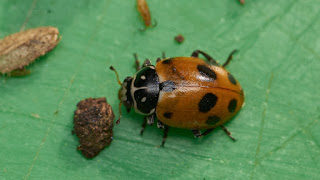This was our 31st and last outing of the season which started way back at the beginning of April. Now I can have a short rest before preparing to start all over again at the start of April 2019.
But first I must report on our visit to this former sand and gravel quarry.
The target for this outing were fungi and Lesne's earwig. We found very few fungi and none of the target earwigs so it was a bit of a failure but we did find plenty of other mini-beasts of interest.
 |
| Photograph: Bob Kemp |
 |
| Photograph: David Williams |
After half an hour or so we moved about 50 yards and repeated the exercise as well as inspecting the area around the pond.
From here we moved into an enclosure that is more of a scrubby grassland.
 |
| Photograph: Bob Kemp |
Out fell a shieldbug. A Juniper shieldbug.
 |
| Photograph: David Williams |
 |
| Photograph: David Williams |
 |
| Photograph: David Williams |
 |
| Photograph: David Williams |
Some of the insects that came our way at this time were an Ant damsel bug:
 |
| Photograph: Bob Kemp |
 |
| Photograph: Bob Kemp |
 |
| Photograph: Bob Kemp |
 |
| Photograph: Nigel Cane-Honeysett |
Another picnic table!
So we dumped our stuff there and looked at the vegetation in its vicinity.
The micromoth Carcina quercana was found in an oak.
 |
| Photograph: David Williams |
We also found a pirate spider Ero furcate:
 |
| Photograph: Bob Kemp |
The temperature continued to plummet. The sun had gone behind thick cloud. We were getting cold. Alternative entertainment was sought.
We moved on to the Station pub at Bridgnorth for an end of season celebration. We were delighted to find the pub sold "Reg May" pork pies.
 |
| Photograph: Bob Kemp |
 |
| Photograph: Bob Kemp |
My thanks to Shropshire County Council for giving us permission to survey the quarry, to the Friends for providing plenty of seats and tables, to the photographers for their excellent pictures and to everyone who has attended any of these events over the past seven months.
Finally, thank you readers for showing an interest in what we do.
Winter well. All being well I will be back next year.


































































